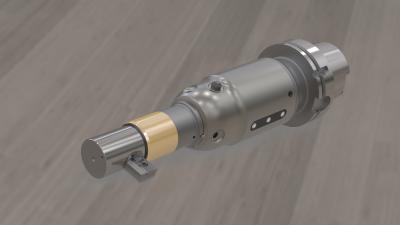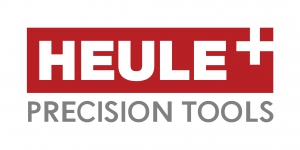
HEULE, a world leader in tool development, introduces SOLO L tooling for spot facing and counterboring projects over 25 mm. Front and back counterbores up to 1.95 x bore diameter can be produced in bores ranging from 25.0mm – 45.0mm in diameter.
SOLO L features a simple, reliable design which functions without an anti-rotation device, change in spindle rotation, coolant pressure, or Contact mechanism. This sealed system prevents coolant contamination, and the pin-driven cutting blade, which moves in and out radially, prevents chips from jamming the system. SOLO L is completely customizable, with the tool’s blade housing, blade control, and blades individually designed to meet specific project requirements. This unique system cuts interruptions and difficult materials like nickel, titanium, and other exotic alloys, making it ideal for a wide range of CNC, transfer, multi-spindle, and conventional machining applications.
The SOLO L uses two centrifugal weights installed in a sealed tool head. With an activation speed rate of 1600 rpm or higher, the weights start moving outwards and turn the gearwheel, which drives the blade out by rotating the blade control. When the spindle is stopped and then actuated to cutting speeds, a pullback spring pushes the centrifugal weights back to the center and the blade extends to the cutting diameter. Maximum machining speed is 900 rpm.
In addition to the L model, three other SOLO models are available, each is capable of counterboring two times the bore diameter minus 1mm. Possible applications up to 40mm through hole depending on the counterbore to bore ration, and parameters (max ratio is dx2-1mm). In most cases through coolant is optional, with a 280-psi maximum.
The SOLO L builds on the reputation that Heule has earned for providing strong automatic back boring tools which cut the most difficult materials and counterbore geometry. Their tools cut on center and are designed to use the maximum pilot size allowed, helping to guarantee stability even in deep hole applications, The patented Heule pin-drive system activates the cutting blade radially, which prevents chips from interfering with the tools operation. Keyed blades with no sharp corners and smooth transitions add strength to both the housing and the cutting blade.
Contact Details
Related Glossary Terms
- alloys
alloys
Substances having metallic properties and being composed of two or more chemical elements of which at least one is a metal.
- boring
boring
Enlarging a hole that already has been drilled or cored. Generally, it is an operation of truing the previously drilled hole with a single-point, lathe-type tool. Boring is essentially internal turning, in that usually a single-point cutting tool forms the internal shape. Some tools are available with two cutting edges to balance cutting forces.
- computer numerical control ( CNC)
computer numerical control ( CNC)
Microprocessor-based controller dedicated to a machine tool that permits the creation or modification of parts. Programmed numerical control activates the machine’s servos and spindle drives and controls the various machining operations. See DNC, direct numerical control; NC, numerical control.
- coolant
coolant
Fluid that reduces temperature buildup at the tool/workpiece interface during machining. Normally takes the form of a liquid such as soluble or chemical mixtures (semisynthetic, synthetic) but can be pressurized air or other gas. Because of water’s ability to absorb great quantities of heat, it is widely used as a coolant and vehicle for various cutting compounds, with the water-to-compound ratio varying with the machining task. See cutting fluid; semisynthetic cutting fluid; soluble-oil cutting fluid; synthetic cutting fluid.
- counterbore
counterbore
Tool, guided by a pilot, that expands a hole to a certain depth.
- counterboring
counterboring
Enlarging one end of a drilled hole. The enlarged hole, which is concentric with the original hole, is flat on the bottom. Counterboring is used primarily to set bolt heads and nuts below the workpiece surface.

